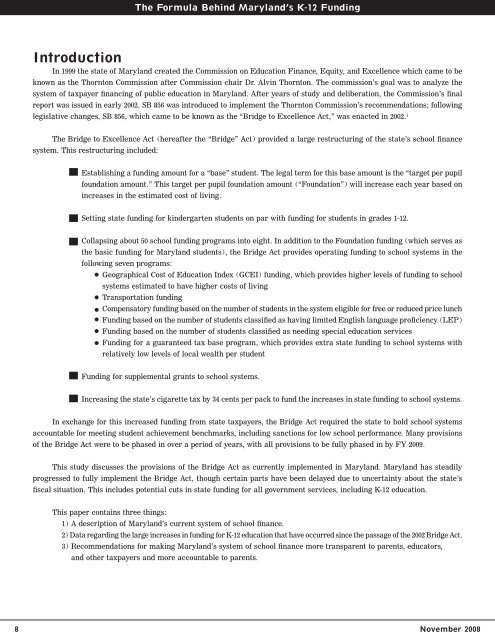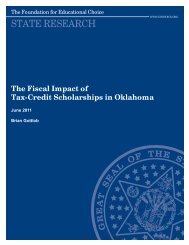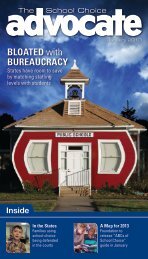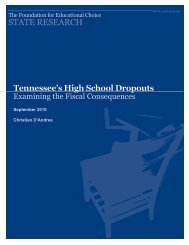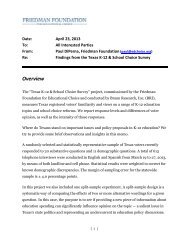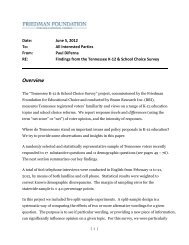View PDF - The Friedman Foundation For Educational Choice
View PDF - The Friedman Foundation For Educational Choice
View PDF - The Friedman Foundation For Educational Choice
Create successful ePaper yourself
Turn your PDF publications into a flip-book with our unique Google optimized e-Paper software.
<strong>The</strong> <strong>For</strong>mula Behind Maryland’s K-12 Funding<br />
Introduction<br />
In 1999 the state of Maryland created the Commission on Education Finance, Equity, and Excellence which came to be<br />
known as the Thornton Commission after Commission chair Dr. Alvin Thornton. <strong>The</strong> commission’s goal was to analyze the<br />
system of taxpayer financing of public education in Maryland. After years of study and deliberation, the Commission’s final<br />
report was issued in early 2002. SB 856 was introduced to implement the Thornton Commission’s recommendations; following<br />
legislative changes, SB 856, which came to be known as the “Bridge to Excellence Act,” was enacted in 2002. 1<br />
<strong>The</strong> Bridge to Excellence Act (hereafter the “Bridge” Act) provided a large restructuring of the state’s school finance<br />
system. This restructuring included:<br />
Establishing a funding amount for a “base” student. <strong>The</strong> legal term for this base amount is the “target per pupil<br />
foundation amount.” This target per pupil foundation amount (“<strong>Foundation</strong>”) will increase each year based on<br />
increases in the estimated cost of living.<br />
Setting state funding for kindergarten students on par with funding for students in grades 1-12.<br />
Collapsing about 50 school funding programs into eight. In addition to the <strong>Foundation</strong> funding (which serves as<br />
the basic funding for Maryland students), the Bridge Act provides operating funding to school systems in the<br />
following seven programs:<br />
Geographical Cost of Education Index (GCEI) funding, which provides higher levels of funding to school<br />
systems estimated to have higher costs of living<br />
Transportation funding<br />
Compensatory funding based on the number of students in the system eligible for free or reduced price lunch<br />
Funding based on the number of students classified as having limited English language proficiency (LEP)<br />
Funding based on the number of students classified as needing special education services<br />
Funding for a guaranteed tax base program, which provides extra state funding to school systems with<br />
relatively low levels of local wealth per student<br />
Funding for supplemental grants to school systems.<br />
Increasing the state’s cigarette tax by 34 cents per pack to fund the increases in state funding to school systems.<br />
In exchange for this increased funding from state taxpayers, the Bridge Act required the state to hold school systems<br />
accountable for meeting student achievement benchmarks, including sanctions for low school performance. Many provisions<br />
of the Bridge Act were to be phased in over a period of years, with all provisions to be fully phased in by FY 2009.<br />
This study discusses the provisions of the Bridge Act as currently implemented in Maryland. Maryland has steadily<br />
progressed to fully implement the Bridge Act, though certain parts have been delayed due to uncertainty about the state’s<br />
fiscal situation. This includes potential cuts in state funding for all government services, including K-12 education.<br />
This paper contains three things:<br />
1) A description of Maryland’s current system of school finance.<br />
2) Data regarding the large increases in funding for K-12 education that have occurred since the passage of the 2002 Bridge Act.<br />
3) Recommendations for making Maryland’s system of school finance more transparent to parents, educators,<br />
and other taxpayers and more accountable to parents.<br />
8 November 2008


